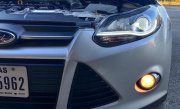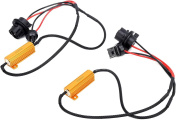
When looking for an automotive light bulb, there are a few terms that you might come across. One of those is HID or high-intensity discharge. HID headlights are becoming increasingly popular in today's automotive market.
Many new cars now come equipped with HID headlights as standard equipment, and more and more aftermarket companies are offering HID conversion kits so that older vehicles can be upgraded to take advantage of this new technology. So, how can you use them, and what are their main characteristics?
What are HID headlights?

HID or high-intensity discharge headlights are a type of automotive light bulb that uses gas discharge technology. HID headlights produce a more powerful light than traditional halogen bulbs, and they also last longer.
HIDs use less energy than halogen bulbs, so they don't put as much strain on your car's electrical system. They also emit less heat, which means they're less likely to cause premature fading of your headlight housing. An HID headlight is made up of an HID light bulb, which has two electrodes enclosed in a glass casing. Xenon gas and metal salts are used to fill this enclosure. In fact, it's the interaction between the xenon gas and metal salts that produces the light.
When the HID light bulb is first turned on, an electric current flows through the electrodes, which ionizes the Xenon gas. This process takes a few seconds to complete. Once the gas is ionized, it becomes electrically conductive, and it can sustain a current without being destroyed.
The electrical current flowing through the gas causes it to emit UV light. This UV light then strikes the phosphors coating on the inside of the glass casing, which converts it into visible light. HID headlights are available in a variety of colors, including white, blue, and yellow. The color of light produced by an HID headlight depends on the type of phosphors used in the bulb.
HID headlights are more expensive than traditional halogen bulbs, but they offer several advantages. HID headlights last longer, use less energy and produce more powerful light. If you're looking for a headlight upgrade, HID headlights are a great option.
What are the disadvantages of HID light bulbs?
However, there are several drawbacks associated with HID light bulbs. Here are some of them.
Poor Color
HPS bulbs have an orange glow that is difficult for the eye to detect. In fact, such color is actually illegal in some states. For example, the blue HID bulbs have a very low Kelvin rating and produce light that is closer to ultraviolet than visible light. This can cause significant eye strain, as well as decreased visibility when driving at night.
High Cost
HID light bulbs are significantly more expensive than halogen bulbs. You may have to spend anywhere from $100 to $300 to get a good quality HID kit. Usually, manufacturers do not include the cost of installation in the price of the kit.
Poor Lumen Maintenance
After a few weeks, HPS bulbs will lose a significant quantity of light intensity before they completely burn out. Poor lumen maintenance is one of the major disadvantages of HPS bulbs. Besides, HIDs also produce a large amount of glare, which can be quite annoying for oncoming traffic.
Overall, with such drawbacks, it is important to consider all pros and cons before making a decision to switch to HID headlights.

How do you tell if you have HID headlights?
Examine the beam pattern to determine whether it is a typical power duration for a halogen bulb, and if so, what wattage. If you turn on your headlights and they flash for a second, that's probably HID (about seven to 10 seconds peak performance and is generally white in color). This is a telltale sign that you have HID headlights.
As HID headlights are more powerful than traditional halogen bulbs, they can provide better visibility in low-light conditions. They also last longer, so you won't have to replace them as often. If you're looking for an upgrade to your current headlight system, HID headlights are a great option.
Moreover, from first sight HID headlights have a brighter and whiter light, which is closer to natural sunlight. This allows better color rendering, so you can see colors more accurately at night. If you're not sure whether your vehicle has HID headlights, consult your owner's manual or ask your dealer.
What is better HID or LED headlights?
Some motorists may wonder whether to purchase HID or LED headlights.
HID stands for high-intensity discharge, and these bulbs produce a much brighter light than traditional halogen bulbs. HID bulbs also last much longer, so they are a good investment for drivers who do a lot of night driving.
LED headlights are newer technology and they are becoming increasingly popular. LEDs use less power than HIDs, so they are more efficient. They also last even longer than HID bulbs, so they may be the best choice for drivers who want the longest-lasting and most efficient option.
Between AC and DC, LEDs are brighter while HIDs offer more light with a longer lifespan. LEDs use electricity, whereas HIDs utilize gas (typically xenon). Both have a higher energy consumption than halogen, but LEDs are slightly more energy-efficient. LED lights may endure up to 45,000 hours compared to 15,000 for HIDs. The lifespan of an LED is about 25 times that of an incandescent bulb and twice as long as a compact fluorescent (CFL).
Finally, when compared with xenon bulbs, LEDs are significantly smaller. This is due to the fact that an HID bulb contains a larger glass capsule, which is necessary to contain the xenon gas.
Xenon headlights may give your car a sleek, modern look, but they can also be a safety hazard. The bright light produced by these bulbs can blind oncoming drivers and cause them to swerve into your lane. If you're considering HID headlights for your car, make sure you understand the risks before making a decision.
Can I just put HID bulbs in my car?

Yes, but you have to use an HID conversion kit. Xenon HIDs are too big for spaces that halogen bulbs occupy, and vice versa.
In order to install HID bulbs for your headlights, follow the next steps. First, clean the surface of your headlight with a clean cloth. Next, use a socket wrench to remove the old bulbs from the headlight. Now take the new HID bulbs and insert them into the headlight. Make sure that they are securely in place before moving on to the next step. Finally, connect the ballasts to the battery of your car. Once everything is properly connected, turn on your headlights and enjoy the improved light output!
If you're not comfortable installing the HID conversion kit yourself, you can take it to a professional mechanic or car stereo installer. Be prepared to pay a bit more for the labor costs. HID headlights are a great way to improve your visibility on the road. But before you purchase a kit, make sure you understand the risks and know how to install them properly. With a little research and care, you can enjoy the benefits of HID headlights without any problems.
How to choose nice HID bulbs?
When selecting HID bulbs, there are a few key factors that you'll want to keep in mind. The first is the color temperature, which is measured in Kelvin (K). The lower the Kelvin rating, the warmer the light will appear; conversely, the higher the Kelvin rating, the cooler the light will appear. Most HID kits on the market today range from 3,000K to 12,000K, with 3,500K-5,500K being considered "factory white" and anything above 6,000K being considered "blue". While blue light is often associated with police lights and other emergency vehicles, it's not necessarily ideal for everyday driving because it can be quite blinding to oncoming traffic.
Another factor to consider is the bulb type. There are two main types of HID bulbs: Xenon and halogen. Xenon bulbs are typically more expensive but they also last longer and produce a brighter light. Halogen bulbs, on the other hand, are less expensive but don't last as long and don't produce as bright of a light.
Brightness and lumens are also important factors to consider when selecting HID bulbs. The brightness of a bulb is measured in lumens, and the higher the lumens, the brighter the light. Most HID kits on the market today range from 1,500 to 3,500 lumens.
Lifespan is also quite an important aspect when it comes to HID bulbs. The lifespan of a bulb is typically measured in hours, and the higher the number of hours, the longer the bulb will last. Most HID bulbs on the market today have a lifespan of 2,000 to 4,000 hours.
Finally, you'll also want to keep in mind the installation ease of the HID bulbs you're considering. Some HID kits are much easier to install than others, so be sure to read the instructions carefully before making your purchase.
Can you interchange the HID headlight with another type?
Drivers may be wondering if they can replace their HID headlights with another type of headlight. The answer is yes, but it is not as simple as just unplugging the old one and replacing it with a new one. There are a few things to keep in mind when considering this switch.
For starters, HID headlights use a different type of light bulb than other headlights. They also require a ballast, which is a unit that provides the necessary power to the light bulb. When you remove an HID headlight, you will need to remove the entire unit, including the ballast.

Another thing to consider is the fact that HID headlights emit a much brighter light than other types of headlights. This can be an issue when you are driving at night, as the bright light can be blinding to oncoming traffic. If you do decide to replace your HID headlights with another type, be sure to keep this in mind and exercise caution when driving at night.
In conclusion, yes, you can replace your HID headlights with another type of headlight. However, there are a few things to keep in mind before making the switch. Make sure you understand all of the risks and know how to properly install the new headlights before making the change.
How can you test headlights after installation?
There are a few ways to test your headlights after they have been installed. One way is to turn them on and off a few times to make sure they are functioning properly. Another way is to take them for a spin at night and see how they look in action. If you notice any problems, be sure to take them back to the store or contact the manufacturer for assistance.
It's also a good idea to have someone else take a look at your headlights after you've installed them. This way, you can get a second opinion and make sure everything looks good. Once you've double-checked everything and are confident that your headlights are installed correctly, you're ready to hit the road!
Final words
Now you know that HID headlights are a great way to improve your visibility while driving at night. You also know that there are a few things to keep in mind before making the purchase, such as bulb type, brightness, and lifespan. And finally, you know how to properly test your headlights after they've been installed.
We hope this guide has been helpful and you're now ready to hit the road with your new HID headlights! Thanks for reading!








